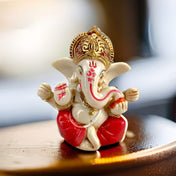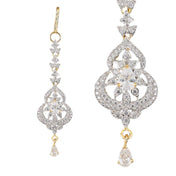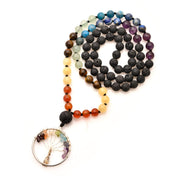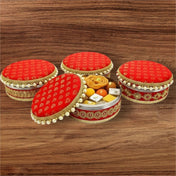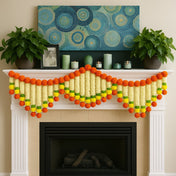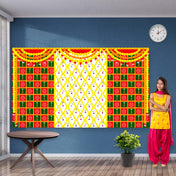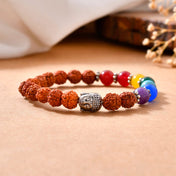Introduction
Indian statues in decor hold profound significance, reflecting rich cultural heritage and artistic traditions. These exquisite pieces not only enhance aesthetic appeal but also serve as reminders of spirituality and history within home settings.
In this blog post, we will explore:
- The historical context of Indian statues
- Popular types of Indian statues suitable for home decor include brass statues and marble representations of deities.
- Tips for incorporating these stunning pieces into your space include selecting a statue of unity or other significant figures that resonate with your style.
- Emotional connections tied to these artifacts
- Recommendations for sourcing authentic Indian statues
Embark on a journey through the world of Indian sculptures and discover how they can transform your living environment.
1. The Historical Context of Indian Statues
The history of Indian sculpture is a captivating journey that spans thousands of years, evolving from primitive forms to sophisticated expressions of art. From prehistoric times, early sculptors began creating rudimentary figures, often linked to fertility and worship.
1. Bronze Age Innovations
This period marked a significant leap in artistry, especially with the advent of bronze casting techniques. The Chola Dynasty (9th to 12th century) became renowned for producing intricate bronze statues showcasing deities with exceptional craftsmanship. These sculptures not only depicted divine forms but also reflected the socio-political landscapes of their time.
2. Brass Age Innovations
The emergence of brass craftsmanship marked a revolutionary period in Indian sculptural arts, particularly during the 8th to 14th centuries CE. This era introduced sophisticated metalworking techniques that remain influential today.
Key Developments in Brass Work
- Lost-Wax Technique: Artisans perfected the dhokra casting method, creating intricate designs with remarkable detail
- Surface Treatments: Development of unique patination processes that gave sculptures distinctive finishes
- Regional Styles: Emergence of distinct artistic traditions in different regions:
- Northern style: Known for geometric precision
- Southern style: Characterized by flowing, organic forms
Technological Advancements
- Introduction of zinc alloy mixtures for enhanced durability
- Development of specialized tools for detailed work
- Implementation of advanced molding techniques
The period saw the creation of both monumental works and intricate domestic items, with artisans achieving new levels of technical sophistication in their craft. Brass sculptures from this era frequently depicted:
- Religious figures with elaborate ornaments
- Court scenes showing royal life
- Daily activities of common people
- Mythological narratives in detailed relief work
These innovations laid the groundwork for many techniques still used by modern Indian sculptors in creating contemporary pieces.
3. Religious Practices
Sculptures hold great importance in the religious beliefs of major faiths like Hinduism, Buddhism, and Jainism. They are used in worship and ceremonies, representing spiritual ideals and stories. Statues of gods such as Ganesha and Gautama Buddha are prime examples, showing how art and spirituality come together.
These religious statues, such as those available in LoveNspire's collection, are more than just decorative pieces; they carry deep meanings of faith and devotion. As we explore the various types of Indian statues that enhance home decor, knowing this historical context helps us appreciate these artistic wonders even more.
2. Popular Types of Indian Statues for Home Decor
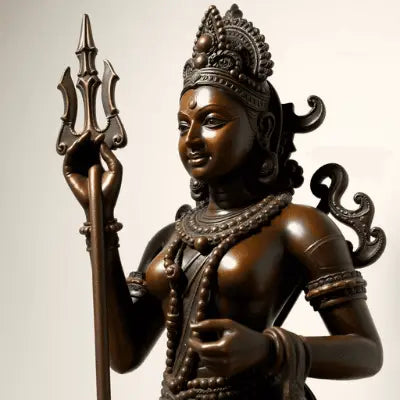
2.1 Bronze / Brass Statues from the Chola Dynasty
Bronze statues from the Chola Dynasty are known for their exceptional craftsmanship and deep artistic expression. These statues date back to the 9th to 12th centuries, a time when bronze casting techniques in South India reached their peak. The artisans of the Chola period mastered the lost-wax method, allowing them to create intricate and durable designs.
Key Characteristics of Chola Bronze Statues:
- Intricate Detailing: These statues feature elaborate carvings that capture the essence of movement and emotion.
- Expressive Features: Facial expressions are crafted with remarkable precision, making each piece come alive.
- Spiritual Significance: Many statues are representations of Hindu deities, each symbolizing different aspects of life and spirituality.
Notable Deities Represented:
- Lord Shiva is frequently represented in various forms, including marble and brass statues, enhancing home décor.: Often depicted in various poses, such as Nataraja, showcasing his cosmic dance.
- Goddess Parvati: Represented as a nurturing figure, embodying love and devotion.
- Lord Vishnu: Frequently shown resting on the serpent Ananta or holding his iconic conch and discus.
Incorporating Chola bronze statues into home decor not only adds visual appeal but also carries cultural significance. Their presence has the power to transform spaces, infusing them with history and spiritual energy. This makes them an ideal choice for individuals looking to embrace Indian culture through their decor choices.
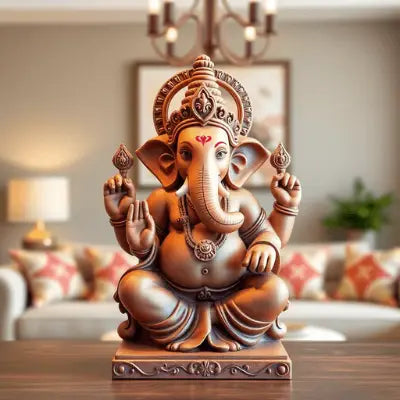
2.2 Ganesha Statues for Home Decor
Ganesha, known as the remover of obstacles, holds a special place in Hindu culture. Revered as the deity of wisdom and prosperity, Ganesha statues are popular choices for Indian statues for home decor. These statues not only serve as beautiful decorative pieces but also resonate with deep cultural significance.
Placement Tips for Ganesha Statues:
- Position the statue at the entrance of your home to invite positive energy.
- Display it in a study or workspace to enhance focus and creativity.
- Avoid placing the statue in bathrooms or cluttered areas to maintain its sanctity.
Incorporating a Ganesha statue for home decor can create an uplifting atmosphere while accentuating your living space's aesthetic. The intricate designs and craftsmanship often reflect traditional styles, making them a perfect blend of art and spirituality in your decor scheme.
Whether you opt for a brass idol like this Ganesha brass idol or a smaller acrylic version, each piece serves as a reminder of the divine blessings that Ganesha brings.
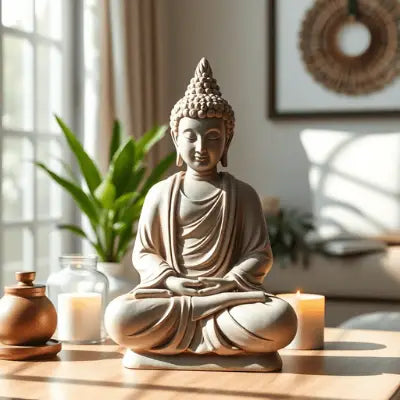
2.3 Gautama Buddha Statues
Buddha statues hold deep meaning and spiritual importance in many cultures, especially in Buddhism. They symbolize the rich cultural heritage and spiritual beliefs of India, often featured in home decoration. enlightenment through the teachings of various spiritual figures represented in art and decoration., calmness, and inner peace, making them powerful additions to home decor. These Indian statues embody the teachings of Gautama Buddha, serving as constant reminders of mindfulness and tranquility.
When integrating Buddha statues into living spaces, consider the following recommendations:
- Placement: Position the statue in a peaceful area, such as a meditation corner or garden, to enhance the serene atmosphere.
- Material Choice: Opt for materials like bronze or resin that resonate with your personal style while maintaining authenticity. For instance, a 4-inch brass Buddha idol sculpture could serve as a perfect addition to your home.
- Complementary Decor: Surround the statue with natural elements like plants or candles to create a harmonious environment.
Incorporating a Buddha statue not only enhances your decor but also aligns with practices like Vastu Shastra, promoting positive energy and balance throughout your home.

2.4 Rajasthani Couple Statues
Rajasthani couple statues are a captivating addition to Indian statues for home decor, embodying the rich cultural heritage of India.
1. Cultural Representation
These figures typically depict traditional attire and vibrant expressions, showcasing the essence of Rajasthani culture. The craftsmanship reflects intricate details, from the elaborate clothing to the delicate ornaments, symbolizing love and togetherness in temple decoration.
2. Rustic Charm
Adding Rajasthani couple statues to your decor can bring a cozy and romantic feel to your home. Whether you put them on a shelf, coffee table, or as part of a gallery wall, these statues add an ethnic touch that enhances any room. Their artistic design works well with different styles, from modern to rustic themes.
Opting for Rajasthani couple statues not only beautifies your space but also creates a stronger bond with India's artistic heritage. Each statue becomes a topic of conversation, inviting admiration and appreciation for its cultural importance.

2.5 Indian Elephant Figurines
Indian elephant figurines are more than just decorative pieces; they hold deep meaning and represent a rich culture. In Indian tradition, elephants symbolize strength, wisdom, and loyalty. They are often connected to Ganesha, the beloved Hindu god known for removing obstacles, is often depicted in various forms of decoration. This association adds a spiritual significance to these delightful sculptures.
When incorporating elephant figurines into your home decor, here are some creative ways to display them:
- Entryway Accent: Place a beautifully crafted elephant figurine near your entrance to greet guests and create an inviting atmosphere.
- Bookshelf Statement: Use a pair of elephant figurines on your bookshelves to add visual interest and showcase your appreciation for Indian culture.
- Centerpiece Focus: Arrange larger elephant statues as focal points on your coffee tables or dining areas, capturing the attention of visitors and sparking conversations about their meaning.
By thoughtfully incorporating these elephant figures into your space, you can enhance both the beauty of your surroundings and the cultural significance they represent.
2.6 Resin Indian Figurines
Resin Indian figurines offer a modern twist on traditional artistry, making them an excellent choice for home decor. These lightweight pieces provide several advantages:
- Durability: Unlike traditional materials, resin is less prone to chipping or breaking, ensuring longevity.
- Versatility: Available in various styles, these figurines can represent Hindu deities or other cultural symbols, allowing for personalized decor choices.
- Affordability: Generally more cost-effective than bronze casting from the Chola Dynasty, resin figurines make cultural art accessible to many.
When integrating resin Indian figurines into your space, consider these styling tips:
- Mix and Match: Pair resin pieces with bronze statues or other decor items to create an eclectic yet harmonious display.
- Placement: Position them on shelves, mantels, or center tables to draw attention and spark conversations.
- Group Arrangements: Cluster smaller figurines together for visual impact and balance.
These elements enhance not only the aesthetic value but also the cultural significance of your decor. To explore a wide range of such exquisite pieces including resin Indian figurines and other traditional handcrafted items, you may want to shop online at LoveNspire, which offers a diverse selection of Indian home decor items, including brass statues and paintings for modern home decoration.
3. Personal Tips for Incorporating Indian Statues into Decor
Choosing the right Indian statue can elevate your space while reflecting personal style and cultural appreciation. Consider these home styling tips:
- Assess Your Space: Evaluate the size and layout of the area where you plan to display the statue. A large, intricately detailed bronze statue may serve as a stunning focal point in a spacious living room, while smaller figurines fit well on shelves or mantels.
- Personal Style Matters: Select statues that resonate with your aesthetic preferences, such as the tallest statue or beautifully crafted brass statues. Whether you gravitate towards traditional designs or modern interpretations, ensure the piece complements existing decor elements.
- Blend Traditional with Modern: Create harmony by balancing ethnic themes with contemporary styles. For instance, pairing a classic Ganesha statue with minimalist furniture can create an intriguing contrast that enhances visual appeal.
- Create Cohesive Displays: Group statues with other decor items, such as textiles or artwork, to form a unified look. Use complementary colors and materials to strengthen the overall aesthetic.
Incorporating Indian statues into your decor not only enriches your space but also fosters connections with cultural heritage and artistry.
4. Emotional Connections with Indian Statues / Hindu God
Indian statues often hold deep emotional significance, weaving stories of family traditions and cultural heritage. Many individuals have cherished memories linked to these pieces of art.
1. Family Traditions
For instance, a Ganesha statue may be part of a family's annual Ganesh Chaturthi celebration, symbolizing the beginning of new ventures and the removal of obstacles. As generations gather to honor this tradition, the statue becomes a cherished heirloom, connecting the past with the present.
2. Cultural Reminders
Statues serve as tangible reminders of values and beliefs, making them essential for both décor and personal inspiration. A Buddha statue might evoke moments of reflection and mindfulness in daily life, encouraging peace and tranquility among family members. Its presence can inspire conversations about spirituality and personal growth.
3. Personal Stories
Each piece carries unique stories. A Rajasthani couple statue could remind someone of joyful family gatherings in their homeland, reflecting the rich cultural tapestry that defines their identity.
These sculptures go beyond mere decor; they encapsulate emotions, memories, and connections that enrich home environments and foster a deeper appreciation for one’s heritage. Each statue has the potential to spark meaningful dialogues about culture and tradition within households.
5. Recommendations for Sourcing Authentic Brass Indian Statues / Idols
When looking for authentic Indian statues, knowing where to buy is important. Here’s a guide that explores your options:
Local Markets
- Pros:
- Direct interaction with artisans allows for negotiation and personal connection.
- Opportunity to observe craftsmanship firsthand, ensuring quality.
- Cons:
- Time-consuming as it may require visiting multiple locations.
- Limited variety compared to online platforms.
Online Stores
- Pros:
- Convenience of browsing a wide range from home.
- Access to customer reviews enhances trust in the purchase.
- Cons:
- Risk of receiving items that do not match descriptions or images.
- Shipping costs and potential delays can be an inconvenience when ordering items like the tallest statue or intricate brass decorations.
Supporting local artisans is vital for preserving cultural heritage. By purchasing directly from them, customers contribute to sustainable livelihoods and fair trade practices, ensuring that artisans are compensated fairly for their craftsmanship.
However, if you're looking for convenience without compromising on authenticity, online stores like LoveNspire offer a wide range of authentic Indian statues including religious idols made from high-quality acrylic. They provide an opportunity to support local artisans while enjoying the ease of online shopping, often with free shipping options.
Understanding the stories behind each piece enhances its value. Engaging with artisans can provide insights into traditional techniques and the significance of various symbols in Indian culture, enriching your decor choices with authenticity and meaning.
Conclusion: Embracing Cultural Art Forms Through Home Decor Choices
Incorporating Indian statues in decor goes beyond just looking good; it helps us appreciate our cultural heritage on a deeper level. These beautiful pieces not only make your space more inviting but also remind us of our traditions and values.
- Reflect on the stories behind each statue.
- Explore how these art forms resonate with your personal journey.
Take this opportunity to create meaningful connections in your home. Let Indian statues connect the past and present, filling your space with their spiritual and artistic significance. You can also strengthen this bond by discovering exquisite Indian handicrafts like traditional diya lamps, which not only brighten up your home but also bring authenticity and warmth to your decor.










